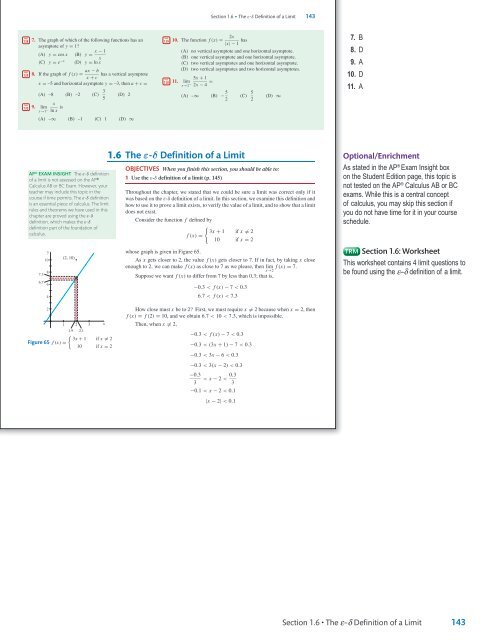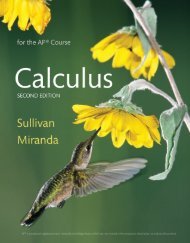Sullivan Microsite TE SAMPLE
You also want an ePaper? Increase the reach of your titles
YUMPU automatically turns print PDFs into web optimized ePapers that Google loves.
<strong>Sullivan</strong> AP˙<strong>Sullivan</strong>˙Chapter01 October 8, 2016 17:4<br />
Section 1.6 • The ε-δ Definition of a Limit 143<br />
PAGE<br />
138 7. The graph of which of the following functions has an<br />
asymptote of y = 1?<br />
(A) y = cos x (B) y = x − 1<br />
x<br />
(C) y = e −x (D) y = ln x<br />
PAGE<br />
139 8. If the graph of f (x) = ax − b has a vertical asymptote<br />
x + c<br />
x = –5 and horizontal asymptote y = –3, then a + c =<br />
3<br />
(A) –8 (B) –2 (C) (D) 2<br />
5<br />
PAGE<br />
x<br />
130 9. lim<br />
x→1 − ln x is<br />
(A) –∞ (B) –1 (C) 1 (D) ∞<br />
PAGE<br />
139 10. The function f (x) = 2x<br />
|x|−1 has<br />
(A) no vertical asymptote and one horizontal asymptote.<br />
(B) one vertical asymptote and one horizontal asymptote.<br />
(C) two vertical asymptotes and one horizontal asymptote.<br />
(D) two vertical asymptotes and two horizontal asymptotes.<br />
PAGE<br />
5x + 1<br />
130 11. lim<br />
x→2 − 2x − 4 =<br />
(A) –∞ (B) − 5 2<br />
(C)<br />
5<br />
2<br />
(D) ∞<br />
7. B<br />
8. D<br />
9. A<br />
10. D<br />
11. A<br />
AP® EXAM INSIGHT The ε-δ definition<br />
of a limit is not assessed on the AP®<br />
Calculus AB or BC Exam. However, your<br />
teacher may include this topic in the<br />
course if time permits. The ε-δ definition<br />
is an essential piece of calculus. The limit<br />
rules and theorems we have used in this<br />
chapter are proved using the ε-δ<br />
definition, which makes the ε-δ<br />
definition part of the foundation of<br />
calculus.<br />
y<br />
10<br />
8<br />
7.3<br />
6.7<br />
6<br />
4<br />
(2, 10)<br />
1.6 The ε-δ Definition of a Limit<br />
OBJECTIVES When you finish this section, you should be able to:<br />
1 Use the ε-δ definition of a limit (p. 145)<br />
Throughout the chapter, we stated that we could be sure a limit was correct only if it<br />
was based on the ε-δ definition of a limit. In this section, we examine this definition and<br />
how to use it to prove a limit exists, to verify the value of a limit, and to show that a limit<br />
does not exist.<br />
Consider the function f defined by<br />
{<br />
3x + 1 if x = 2<br />
f (x) =<br />
10 if x = 2<br />
whose graph is given in Figure 65.<br />
As x gets closer to 2, the value f (x) gets closer to 7. If in fact, by taking x close<br />
enough to 2, we can make f (x) as close to 7 as we please, then lim f (x) = 7.<br />
x→2<br />
Suppose we want f (x) to differ from 7 by less than 0.3; that is,<br />
−0.3 < f (x) − 7 < 0.3<br />
6.7 < f (x)




